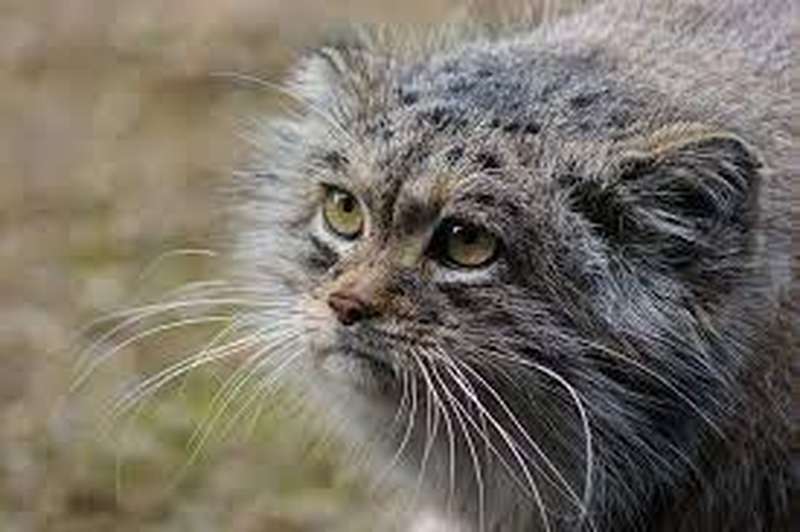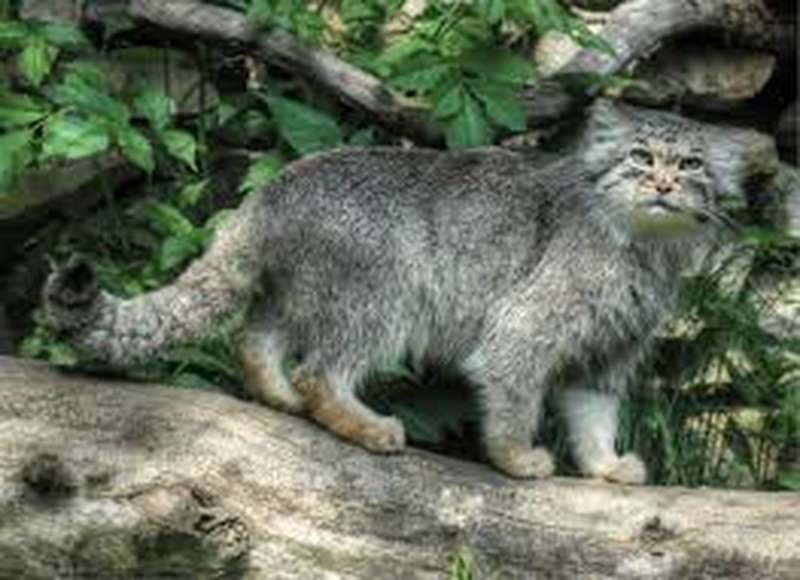The Pallas’ cat (Otocolobus manul) is a small wildcat famous for its unique and charming appearance. It has a flattened and rounded face, a sturdy body, and an incredibly fluffy coat, which gives it a stout and plush appearance.
The Appearance of Pallas Cat

The Pallas’s cat is approximately the same size as a domestic cat, but its stocky build and long, thick coat gives it the appearance of being much more extensive.
This physical adaptation not only contributes to its overall size but also serves as protection in its cold habitat. The lynx has a shaggy coat that is particularly thick on its belly, protecting it from the snow as it hunts for prey.
The fur undergoes a color change depending on the season. It appears as a frosted grey in winter, while in spring, it takes on a gray/fox-red hue.
Unlike other small cats, the pupils of the lynx’s large eyes contract into small circles instead of slits.
Facts about species
According to some researchers, Manul, also known as Pallas’s cat, is considered to be the oldest living cat species. The evolution of this dates back as far as ten million years.
Scientific Designation: Otocolobus manul
Endangered Status: Least Concern (LC)
Lifespan: Up to 11.5 years
Weight: 2-5 kg
Body Length: 50-65 cm
Tail Length: 21-31 cm
Behavior
Being naturally nocturnal, Pallas cat spends its days in caves, rock crevices, or marmot burrows. It emerges in the late afternoon to start its night of hunting.
But given that its prey is active throughout the day, it is probably a daily cat. These cats hunt by stalking or creeping up on their prey, as their short legs do not allow them to run well.
These cats primarily rely on their sight for hunting. They utilize sparse vegetation as camouflage while stalking their prey.

Their low-set ears and flat forehead are adaptations that help them hunt in open terrain. The Pallas cat primarily feeds on pikas, gerbils, voles, mouse-like rodents, and chukar partridge.
Range of Species
The distribution of the Pallas cat ranges throughout Asia and the Middle East. The cat is found in central Asia and can be found in uplands, hilly areas, steppes with rocky outcrops, and semidesert areas.
It is particularly plentiful in the cold grasslands of Mongolia and Inner Mongolia. It can be found at elevations ranging from lower levels to 3,000 to 4,000 meters.
The typical habitat of this species is known for its extreme continental climate, which is characterized by minimal rainfall, low humidity, and a wide range of temperatures.
Endangered Pallas’s Cats
The Pallas’s cat, also known as the manul, is primarily threatened by hunting for its fur.
The International Union for Conservation of Nature (IUCN) has classified this species as Least Concern (LC), and it is protected under Appendix II of the Convention on International Trade in Endangered Species (CITES).
Habits and lifestyle
Pallas’s cats are known for their secretive and solitary nature. They move with deliberate slowness, carefully concealing themselves within their surroundings and effortlessly blending into the background.
They are primarily active during twilight hours, known as crepuscular, but in certain regions, they may also exhibit activity during daylight hours. Pallas’s cats seek shelter in rock crevices or small caves during the daytime.
The most common place they choose is the abandoned burrows of marmots. Male animals typically occupy larger territories compared to females, and these territories often overlap with those of a few females.

Both males and females engage in scent marking to establish their colony. They are skilled predators that employ a stalking and ambushing technique to hunt their prey.
They move swiftly and seize opportunities to pounce on their unsuspecting victims. They wait at the entrances of caves, ready to pounce as soon as the animal exits.
When Pallas’s cats are excited, they emit a growling or yelping sound that resembles that of a small dog. In addition, they have the ability to purr.
Nutrients and Diet
Pallas’ cats are carnivorous animals that primarily feed on small rodents and pikas.
Small mammals such as mouse hares, murines, ground squirrels, and voles are commonly consumed, along with small birds, grasshoppers, and lizards.
Mating habits
Pallas’s cats exhibit a polygynous mating system, wherein males mate with multiple females within a specific breeding season.
During mating, the male closely accompanies the female for multiple days, possibly to protect her from potential advances by other males. The breeding season of this species occurs from December to March.
A litter of 3 to 6 kittens is typically born after 9 to 10 weeks gestation. The kittens typically remain inside their den until they reach two months of age.
It is during this time that they undergo a process called “molting” and develop their adult coat. At the age of 3 to 4 months, the kittens start following their mother in social groups to forage for food.
Kittens typically disperse when they are between 4 to 5 months old, which is when they have reached their adult size and weight.
Young individuals have the ability to disperse a considerable distance away from their maternal den, and they also exhibit a rapid rate of maturation. They reach reproductive maturity within their first year of life.
How many kittens do Pallas cats typically have?
Pallas cats typically give birth to litters consisting of one to six kittens, with three or four being the most frequently observed number.
Pallas cat kittens possess a dark, woolly coat that they shed at approximately two months of age. Kittens typically become independent between the ages of four and five months.
Female Pallas cats experience a brief mating season that lasts for only two to four days each year. This season typically occurs between December and March.
After mating, the gestation period lasts for approximately 66 to 75 days. Consequently, the kittens are typically born between late March and May. Pallas cats typically reach sexual maturity at approximately 9 to 10 months of age.
What predators does the Pallas cat have?
Some examples of raptors include eagles and other birds of prey. Grey wolves, herding dogs, and red foxes are also notable animals.
Humans also hunt them for their pelts, primarily in Mongolia, where hunting is legally permitted. In China, they can also be hunted with a special license.
In many cases, Pallas cats are unintentionally shot due to mistaken identity with marmots, as marmots are commonly hunted throughout the Pallas cat’s habitat.
In Mongolia and Russia, Pallas’s Cats’ fat and organs are used for medicinal purposes.
Pallas’ cats are the furriest.
The length of their fur is almost twice as long on their belly and tail compared to their top and sides. Presumably, this helps to keep the cats warm while they hunt on snow or frozen ground.
The fur of these animals undergoes seasonal changes in both length and density, becoming longer and thicker during the winter months.
Pallas’ cats undergo two significant color phases. During the winter season, the coats of these animals appear grayer and exhibit a more consistent color.
However, in the summer, their fur displays a greater number of stripes and ochre hues. Their tails are adorned with black rings, while their foreheads display scattered black spots.
Dark lines extend from their eyes, gracefully running down their cheeks. The frosted, silvery appearance of their coats is a result of the white tips of their hair.
Pallas’ cats are expert ambush hunters.
They stealthily track their prey by utilizing the concealment provided by short vegetation and rocky terrain.
Alternatively, they patiently position themselves near burrow entrances, ready to ambush their targets as they emerge.
Pallas’ cats primarily hunt pikas, along with other small rodents, birds, and occasionally insects.
Interesting Facts for Children
- The cats were named after Peter Pallas, an eighteenth-century German zoologist, in 1776. The term ‘manul’ originates from the Mongolian language.
- The scientific name of Pallas’s cat, Otocolobus, originates from Greek and translates to “ugly-eared.”
- When Pallas initially described this cat, he made the incorrect suggestion that it was the ancestor of the domestic Persian cat. This was due to its stout build, long fur, and flattened face.
- Despite their small size, Pallas’s cats exhibit aggression similar to that of much larger cats. Even before they can open their eyes, these kittens will growl.
- Pallas’s cats have limited running abilities because of their compact bodies. Instead of fleeing from danger, they choose to seek refuge in small crevices or near boulders when they are being pursued.
- Pallas’s cats appear larger and heavier than their actual size because of their long, thick coats and sturdy body structures. In fact, they are similar in size to domestic cats.
- The Pallas’ cat has a compact body, which makes it less proficient at running. When being chased, it seeks refuge by climbing onto boulders or hiding in small crevasses.
- Pallas’ cats are known to produce a diverse range of sounds. When they are excited, they emit a sound similar to that of a small dog, either a yelp or a growl. Pallas’ cats are also capable of purring.
- Their pupils are unusual. Pallas’ cats, unlike other cats, have pupils that contract into small circles instead of vertical slits.